Assessment of natural catastrophes (2003-2013)
 Storm Phoenix in the United States in 2011© Alain Stark, CC BY-SA 2.0
Storm Phoenix in the United States in 2011© Alain Stark, CC BY-SA 2.0Evolution of natural catastrophes: 2003-2013
Damage in billions USD| year | Number of events | Economic losses | Insured losses | % insured | Number of victims |
|---|---|---|---|---|---|
| 2003 | 142 | 65 | 16 | 24,6% | 37 821 |
| 2004 | 116 | 120 | 46 | 38,3% | 292 800 |
| 2005 | 149 | 220 | 78 | 35,5% | 88 000 |
| 2006 | 136 | 43 | 11,8 | 27,4% | 22 400 |
| 2007 | 142 | 63,7 | 23,3 | 36,6% | 14 600 |
| 2008 | 137 | 258 | 44,7 | 17,3% | 234 900 |
| 2009 | 133 | 50 | 22 | 44% | 9 000 |
| 2010 | 167 | 194 | 40 | 20,6% | 297 000 |
| 2011 | 175 | 362 | 110 | 30,4% | 29 000 |
| 2012 | 168 | 178 | 71 | 39,9% | 9 000 |
| 2013 | 150 | 131 | 37 | 28,2% | 20 000 |
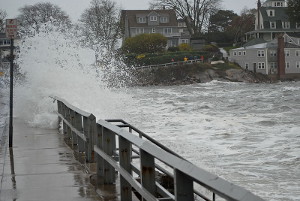 Floods caused by Hurricane Sandy © The Birkes, CC BY 2.0 Floods caused by Hurricane Sandy © The Birkes, CC BY 2.0 |
During recent decades, the rise of extreme events due to weather factor has contributed to the increase in claims covered by insurers. Such claims have increased from 16 billion USD in 2003 to 78 billion USD in 2005, then to 110 billion USD in 2011, to decline again to 37 billion USD in 2013.
The most costly events for insurers during the 2003-2013 period are:
- hurricanes Katrina (2005) and Sandy (2012) in the United States,
- earthquakes in Chile in 2010 and Japan in 2011,
- series of winter storms in Europe in 2013.
Worldwide insured losses and number of casualties of natural catastrophes: 2003-2013 period
in billions USD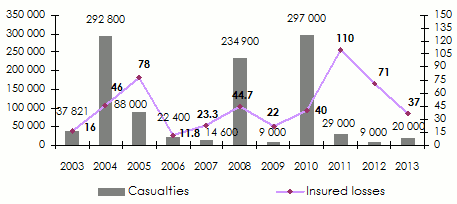 Source: Swiss Re
Source: Swiss Re Impact on reinsurance
Reinsurance treaties include generally a clause that defines the catastrophic event. According to reinsurers, all claims arising from a single and only cause constitute an event. These claims are limited in space and time. Example: an event occurring in a given area during a maximum period of 72 consecutive hours.
The intensity and increase of weather events can be accounted for by some natural and human factors:
- global warming caused by greenhouse gas emissions,
- melting ice,
- economic development,
- high population growth,
- the progression of uncontrolled urbanization.
These factors continue to generate record economic losses and weigh on populations, governments and on the insurers of the ever-rising costs.
The most costly events for the 2003-2013 period
Damage in millions USD| Date | Event | Country | Casualties | Insured losses (1) |
|---|---|---|---|---|
| 25/08/2005 | Hurricane Katrina | United States, Gulf of Mexico, Bahamas, North Atlantic | 1 836 | 80 373 |
| 11/03/2011 | Earthquake of magnitude 9 and tsunami | Japan | 19 135 | 37 665 |
| 24/10/2012 | Hurricane Sandy | United States | 237 | 36 890 |
| 06/09/2008 | Hurricane Ike | United States, Gulf of Mexico, Caribbean | 136 | 22 751 |
| 02/09/2004 | Hurricane Ivan | United States, Caribbean , Barbados | 181 | 17 218 |
| 27/07/2011 | Heavy rains, floods | Thailand | 124 | 16 519 |
| 22/02/2011 | A magnitude 6.3 earthquake | New Zeland | 815 | 16 142 |
| 19/10/2005 | Hurricane Wilma, floods | United States, Mexico, Jamaica, Haiti | 35 | 15 570 |
| 20/09/2005 | Hurricane Rita, floods | United States, Gulf of Mexico, Cuba | 34 | 12 510 |
| 15/07/2012 | Drought in the «Corn Belt» | United States | 123 | 11 594 |
| 11/08/2004 | Hurricane Charley, floods | United States, Cuba, Jamaica | 24 | 10 313 |
| 27/02/2010 | A magnitude 8.8 earthquake | Chile | 562 | 8 876 |
| 22/04/2011 | Severe storms, tornadoes | United States | 354 | 7 856 |
| 20/05/2011 | Severe storms, tornadoes | United States | 155 | 7 587 |
| 18/01/2007 | Winter storm Kyrill | Germany, United Kingdom, Netherlands | 54 | 7 112 |
| 26/08/2004 | Hurricane Frances | United States, Bahamas | 38 | 6 593 |
| 22/08/2011 | Hurricane Irene, floods | United States | 55 | 6 274 |
| 04/09/2010 | A magnitude 7 earthquake | New Zeland | - | 5 548 |
| 13/09/2004 | Hurricane Jeanne, floods | United States, Caribbean and Haiti | 3 034 | 4 872 |
| 06/09/2004 | Typhoon Songda | Japan, South Korea | 45 | 4 593 |
| 02/05/2003 | Storms, tornadoes, hail | United States | 45 | 4 216 |
| 27/05/2013 | floods | Germany, Czech Republic, Austria | 25 | 4 134 |
| 27/07/2013 | Hailstorms | Germany, France | - | 3 838 |
| 24/01/2009 | Winter storm Klaus | France, Spain | 25 | 3 406 |
On a decade of natural catastrophes, three years were marked by record high economic losses:
2005: hurricane Katrina, alone, is an evidence of the scale of material damages that can affect reinsurers. With 135 billion USD in economic damages, Katrina, hence, accounts for more than 60% of the overall cost of natural catastrophes damages in 2005. The amount of insured losses for this disaster only amounts to 80 billion USD .
2008: the Sichuan earthquake occurring in China has generated 124 billion USD of economic losses and just 366 million USD of insured damages
2011: the Japan earthquake alone caused 210 billion USD in economic damage compared to a total of 370 billion USD for the entire year 2011. Only 37 billion USD were covered by insurers.
It is the industrialized countries that report significant insured losses due to their high insurance density, risk exposure of living areas, sophisticated level of infrastructure and sums insured.
In contrast to industrialized countries, emerging states suffer greater casualties and relatively little economic and insured damages. Examples:
- 2005 Kashmir earthquake: more than 73 300 deaths, and just 5 billion USD in economic damages,
- 2008 Cyclone Nargis: 138 373 deaths and 10 billion USD in economic damage.
The large gap between economic damage and insured losses strains emerging states’ economies rendering them more vulnerable. In 2013, the overall deficit between economic and insured losses amounted to 104 billion USD.
2013, a mild year for reinsurers
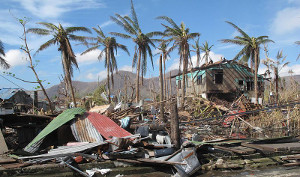 Typhoon Haiyan, Philippines © DFID, CC BY 2.0 Typhoon Haiyan, Philippines © DFID, CC BY 2.0 |
Both economic and insured losses have significantly improved in comparison with 2012. Economic losses went from 178 billion USD in 2012 down to 131 billion USD in 2013, that is a decline of 26%.
During the same period, insured losses, worth 71 billion USD in 2012, went down by 48% to attain 37 billion USD in 2013, 20 billion USD of which were borne by Europe and the United States. Asia is more affected by human losses than by insured damages.
Typhoon Haiyan, alone, claimed the lives of more than 7 000 people in the Philippines in 2013.
Nomenclature of natural catastrophes
We complete this assessment of natural catastrophes by proceeding to the definition of major events such as flood, hurricane, drought, storm, tornado, tsunami, tidal wave, and earthquake.
Flood
A flood occurs when an area is submerged by water. It can be disastrous when it is violent and triggers serious consequences on people, their property and environment. The 2013 India floods have claimed the lives of 5748 people and caused damage worth more than 1 billion USD.
Hurricane
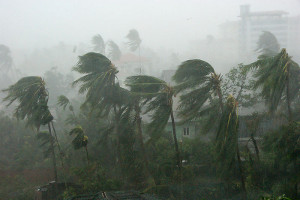 Cyclone Nargis, Myanmar © Mohd Nor Azmil Abdul, CC BY 2.0 Cyclone Nargis, Myanmar © Mohd Nor Azmil Abdul, CC BY 2.0 |
A hurricane refers to a cyclonic disturbance whose speed may reach over 120 km / h. The intensity of a hurricane is measured by the Saffir-Simpson scale which comprises five levels.
Level 1, the lowest, corresponding to a wind speed of 118 to153 km / h and a wave (1) of 1.2 to 1.7 m.
A major hurricane is referred to when it reaches category 3 or higher, then it may exceed a wind speed over 250 km/h and a wave (1) greater than 5.5 m.
The use of the word hurricane varies according to regions. We refer to:
- hurricane in the North Atlantic and the Pacific Northeast. "Katrina" (USA) occurred in 2005 in the United States and remains the most expensive hurricane with over 135 billion USD in economic damages
- typhoon in East Asia. "Haiyan" (The Philippines) in 2013 claimed the lives of more than 7 000 people and caused more than 12 billion USD in economic losses.
- tropical cyclone in the Indian Ocean. "Gafilo" (Madagascar), which lashed the big island in 2004, causing 250 million USD in economic damage.
How to assign a name to a cyclone?
The nomenclature of tropical cyclones dates back to the 18th century, with only female names being initially attributed. This naming system was revised in 1979.
Ever since, specialists decided to give each event a name, female or male, depending on the year of occurrence. The first cyclone of an odd year receives a female name, the second in the same year a male name, the third a female name, etc.
Then the first cyclone of an even year receives a male name, the second in the same year a female name, etc.
The list of names is prepared in advance for the next six years, with each region receiving its own list, established by the meteorological services of each ocean basin (Atlantic, Pacific and Indian).
Seismic wave: overall vibrations exerted by the magnitude of an earthquake on Earth's surface or at its epicenter. The higher the magnitude of an earthquake is, the more, the wave applied to the surface of the ground gets violent.
Drought
Drought refers to a shortage of rainfall in a given period. It varies according to the different regions of the world and their water resources. Over a long period of drought, the latter may have an impact on the flora and fauna. With 60 million tons of damaged corn, the "Corn Belt" drought that was reported in the United States in 2012 accounted for 15 billion USD in economic losses.
Storm
A storm is a violent phenomenon characterized by wind gusts and heavy rainfall. It may be accompanied by thunderstorms, hail, and tornadoes.
A storm can severely damage a region. Winter storm Kyrill, which hit northern Europe in 2007, cost more than 10 billion USD in damage.
Tornado
A tornado is a whirlwind of extremely high speed of up to 113 km/h. It picks up initially from a storm cloud.
A tornado is classified into six categories graduated from FO to F5 according to the Fujita scale which is used to measure the scope and severity of the damage a tornado can cause.
The United States is the hardest-hit in terms of the largest number of tornadoes. 800 to 1300 tornadoes are observed every year in this country, twenty of which may reach F4 or F5 level. They cause an average of 80 deaths per year.
Tsunami and tidal wave
A tsunami or tidal wave in some countries is made up of a series of waves spread out through an aquatic environment usually caused by an earthquake or volcanic explosion. Upon reaching the coast, a tsunami may turn into very high cresting waves.
Tsunamis are among the most destructive natural catastrophes in history. With more than 250 000 victims, the 2004 tsunami in the Indian Ocean remains the deadliest disaster reported in the past 30 years while that of Japan in 2011 is the most expensive event with more than 210 billion USD in economic damage.
Earthquake
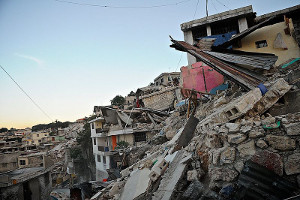 Haiti following the January 2010 earthquake © Colin Crowley, CC BY 2.0 Haiti following the January 2010 earthquake © Colin Crowley, CC BY 2.0 |
An earthquake is the result of vibrations of the earth's crust caused by seismic waves carried on the rocks. Its intensity is measured by the Richter scale based on the magnitude. An earthquake with a magnitude less than 1.9 is a micro earthquake not felt while another one which is reaching or exceeding magnitude 9 may devastate areas covering a radius of 1000 miles.
The 2010 earthquake in Haiti of a 7.3 magnitude claimed more than 222 000 lives, that of Kobe, in Japan in 1995, with a 7.2 magnitude killed 6 437 people and caused nearly 150 billion USD in economic damage.
